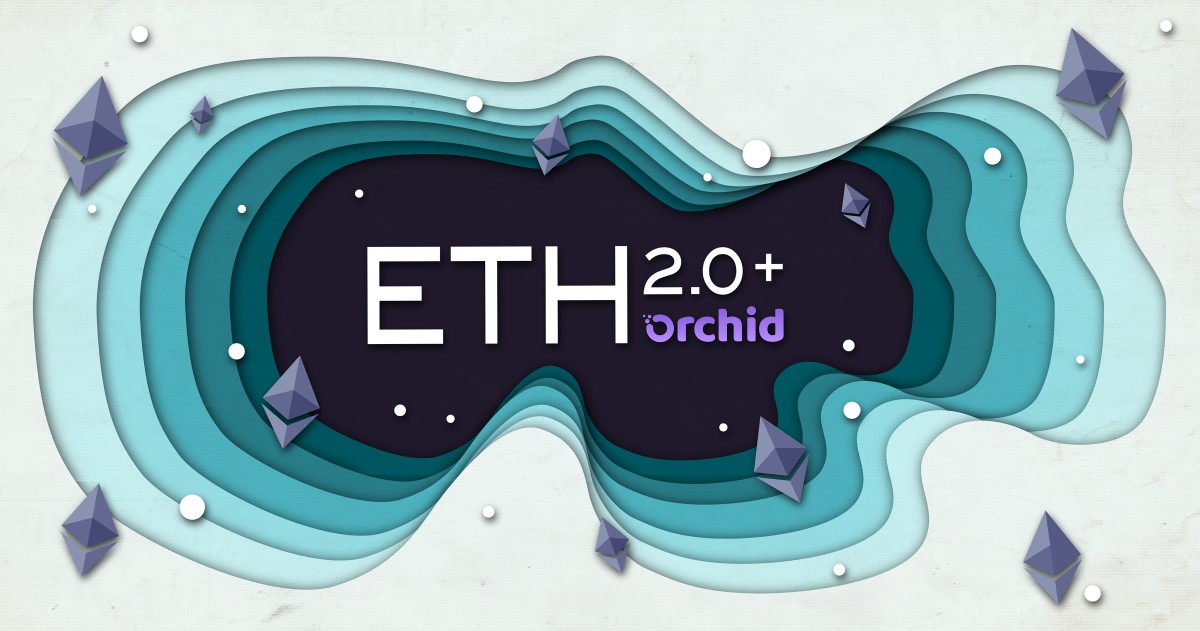
What Does Ethereum 2.0 Mean for Orchid?
Jun 29, 2021One of the biggest stories of 2020 in the blockchain space was the much-anticipated launch of Ethereum 2.0. After years of delay -- which led to growing doubt in some quarters about the overall viability of the project -- the proof-of-stake (PoS) chain finally went live in the fourth quarter of last year, and has since seen steady growth in the amount of assets staked.
What does this mean for Orchid? Obviously, the emergence of Ethereum 2.0, or Eth2.0, has important implications for the entire Ethereum ecosystem and community. Explosive growth over the past year has caused pain points to arise for layer-2 solutions built on the network -- most notably in the form of high gas fees. Orchid has addressed these issues by adding multi-chain capabilities that have reduced the initial buy-in required to use the service to as little as $1.
The migration of projects to Ethereum 2.0 holds out the prospect of changes to some aspects of functionality and user experience. Perhaps most central are the implications around ETH itself; some have applied the term "ultra-sound money" to Ethereum 2.0. What does this mean from an economic perspective, and what are the implications for OXT and for Orchid's system of probabilistic nanopayments?
In this piece, we will seek to answer these questions by exploring the likely implications of Ethereum 2.0 for Orchid, its users, and those who provide bandwidth on the network.
Why is the upgrade to Eth2.0 necessary for the growth of Ethereum-based projects?
Before we dive into the specifics of how Orchid might be affected by the switch to Ethereum 2.0, it's useful to look at the current state of the Ethereum ecosystem and the reasons the software upgrade is needed in the first place.
Historically speaking, Ethereum gas fees have been relatively higher than transaction fees on other layer-1, smart contract-enabled blockchain networks. But it wasn't until the explosive growth of the Ethereum decentralized finance (DeFi) ecosystem in 2020 and 2021 that ETH gas fees really started to bite.
At their highest points in 2020 and 2021, gas fees on Ethereum soared--depending on the type of transaction, they could cost as much as several hundred dollars. The high fees were widely described as a major obstacle to the growth of the Ethereum network and a barrier to widespread adoption. As a result, developers seeking a cost-friendly environment for their decentralized applications began to look beyond Ethereum for lower-cost alternatives.
It is no surprise that finding a solution for high gas fees on Ethereum has been a key priority for developers this year. Indeed, as fees on Ethereum were peaking, other smart contract-capable layer-1 chains began to grow in popularity. At one point, the number of daily transactions on the Binance Smart Chain--which charges a few cents for each transaction--surpassed daily Ethereum transactions by more than 600 percent.
Orchid, like all Ethereum-based projects, is affected by fluctuations in gas prices. Because OXT, Orchid's native digital currency, is an ERC-20 asset, OXT payments on the network also require ETH payments to cover gas costs. As a result, users who wish to fund their accounts with OXT have exposure to high gas fees.
To alleviate this exposure, in March Orchid added support for xDai, resulting in a major cost reduction -- people can now get started on the app for as little as $1. A number of other projects have also added multi-chain support, which has significantly reduced the cost of their services.
In the long run, many are hopeful that the upgrade to Eth2.0 will result in sustainably lower gas fees across the Ethereum ecosystem.
How will Eth2.0 mitigate high gas prices?
Gas fees on Ethereum are determined by two factors: the price that transaction senders are willing to pay, and the fee that miners are willing to accept. This is because the network relies on a sort of auction-based system to set gas prices. When a transaction is sent, the sender "bids" how much they're willing to pay. This bid is called the "gas limit."
Once the gas limit is set, miners have the option to select a transaction for inclusion in their next block. In theory, this auction-style model should give senders the ability to prioritize their transactions: they can pay higher fees when a transaction needs to be processed quickly, and a lower fee when a transaction isn't time-sensitive. In reality, however, prices have become so high that many people simply cannot pay them -- relegating even important transactions and saddling the network with slow speeds and bottlenecks.
For Ethereum to truly scale, gas fees must come down
However, while xDai and a number of other solutions have been developed to address high gas prices on the Ethereum blockchain, developers agree that the network's underlying fee structure must be addressed in order to make meaningful, widespread adoption of Ethereum itself possible.
One of the solutions that has been proposed is Ethereum Improvement Proposal (EIP) 1559. If miners agree, the proposal would introduce a new fee structure involving two different costs: a base fee and an inclusion fee. The base fee represents the minimum costs of running the transaction, while the inclusion fee is a tip for miners. Instead of being paid to miners, the base fee will be burned.
However, addressing the fee structure in and of itself is not enough. This is because Ethereum's high transaction costs are closely related to another of the network's problems: scalability.
How will Eth2.0 affect transaction speeds?
At present, the Ethereum network is capable of processing some 10-15 transactions per second. In moments of high traffic, this can create a bottleneck effect that slows transaction speeds and, because of Ethereum's fee auction model, increases costs.

The Ethereum developer community has designed a solution to address both high transaction costs and slow transaction speeds on the Ethereum network at once. This solution is called sharding.
Sharding is a proposed method, essentially, of splitting Ethereum's infrastructure into smaller pieces. Theoretically, this should decrease the load on each individual node, thereby allowing for a larger transaction throughput. While it's difficult to determine exactly how much the upgrade to Eth2.0 will cut transaction fees, it's estimated that Eth2.0 will be capable of running more than 100,000 transactions per second.
Currently, Orchid's nanopayment system can support several million users sending probabilistic transactions in OXT each second -- a tremendous capacity to provide digital privacy solutions around the world. However, the sharding infrastructure outlined in the plan for Eth2.0 has the potential to be truly transformative, allowing Orchid to handle billions of OXT transactions per second.
However, it could be a long time before sharding is live on Ethereum. The full migration from Eth1.0 to Eth2.0 is expected to take several years to be completed. In the meantime, Orchid's system of probabilistic nanopayments -- a unique layer-2 scaling solution -- is capable of handling exponentially higher transaction volumes than Ethereum itself.
In fact, Orchid nanopayments can run on any chain compatible with the Ethereum Virtual Machine (EVM). If ETH has high gas fees due to low transaction throughput, users have the ability to house their Orchid accounts on other chains with lower gas fees -- making the service more affordable and reliable. Some chains, such as xDAI, have also locked their gas fees, providing much greater stability and giving users confidence that prices and fees will not fluctuate as a result of rising gas prices.
Nanopayments allow transactions within the Orchid ecosystem to happen almost instantaneously. However, since they must eventually "settle" through on-chain transactions, high gas prices do get passed through to Orchid users whose accounts are funded with OXT. But this problem is easy to avoid: by housing their accounts on another EVM-compatible chain, such as xDAI, people can insulate themselves from the effects of high fees on Ethereum.
Ethereum's switch to Proof-of-Stake: what does it mean for Orchid?
Beyond changes to fee structures, EIP-1559, and the implementation of sharding, the move to Eth2.0 will change the very nature of the Ethereum network itself. How? At full implementation, Ethereum will no longer run on a Proof-of-Work consensus algorithm. Instead, the network will operate on a Proof-of-Stake (PoS) consensus algorithm.
When Ethereum fully migrates to a PoS model, blocks of transaction data will be confirmed by stakers instead of miners. Stakers are entities that have locked at least 32 ETH into the Ethereum ecosystem. After these funds have been secured, stakers are chosen at random to validate transaction data. In exchange, new ETH is created and distributed as rewards.
Because PoS networks create and distribute new tokens as rewards for stakers, the native tokens of many PoS networks are subject to inflation. To combat this inflationary effect, EIP-1559 will introduce a token "burn" mechanism that will act as a deflationary counterforce. This introduction of scarcity to the Ethereum network has been touted by some as being likely to make ETH into a so-called "hard" asset, an "ultra-sound money."
How Will Ethereum's PoS Consensus Model Impact Orchid?
Will these changes to the token economics of the Ethereum network have a direct impact on Orchid? Theoretically, the answer is yes. However, the specifics of these impacts are unclear.
As an ERC-20 asset, OXT is subject to changes in the underlying Ethereum network on which it is built. This is important for providers, who must stake OXT in an Ethereum-based smart contract to advertise their services to clients. They are randomly selected by users weighted by proportional stake (in other words, that the probability of picking a particular provider is determined by the amount of OXT that they have locked in Orchid's ecosystem.)
Therefore, even though Orchid users have the option to house their accounts on other EVM-compatible chains, providers have exposure to ETH through the OXT staking requirement. These providers also receive income in the form of OXT from users whose accounts are housed in OXT. So the switch to PoS and changes to Ethereum's tokenomics could have an impact on Orchid's bandwidth providers in particular.
Beyond possible effects on gas fees, it's unlikely that Ethereum's switch to Proof-of-Stake will have a direct impact on Orchid's economic ecosystem. Instead, the increased scalability that the switch to PoS could bring to Ethereum is much more likely to have an indirect effect on the economics of Orchid.
Orchid's VPN service is priced in dollar terms -- currently $0.06/GB. Therefore, fluctuations in the price of OXT relative to USD affect the amount of bandwidth a given account can buy, so increased scalability as a result of PoS could drive down costs for those funding their accounts with OXT. However, Orchid's multi-chain compatibility already offers prices as low as $1. And users purchasing bandwidth with XDAI, a stablecoin, are not subject to loss or gain due to currency fluctuations.
What does this all mean for Internet privacy?
While it's impossible to determine exactly how the switch to Eth2.0 will affect Orchid, the increased likelihood of lower transaction costs and higher transaction speeds on Ethereum would, if anything, seem likely to make the Orchid network even more scalable and efficient. Eth2.0 stands to further enhance the incentives, benefits, and user experience of projects like Orchid.
Ultimately, Eth2.0 -- and any technology that makes privacy stronger or more accessible -- is poised to further advance Orchid's vision: to make Internet privacy accessible for everyone. Through our unique system of probabilistic nanopayments and integration with xDAI, we have already pushed the boundaries of speed and cost for a decentralized platform built on Ethereum. Orchid provides an easy-to-use, affordable, and fast digital privacy solution; the move to Eth2.0 promises to accelerate this progress and move us further toward Orchid's vision of a free and open Internet for all.
Download Orchid today to start exploring the Internet freely.
If you enjoyed this blog, subscribe here for privacy news, commentary, and product updates from Orchid.



